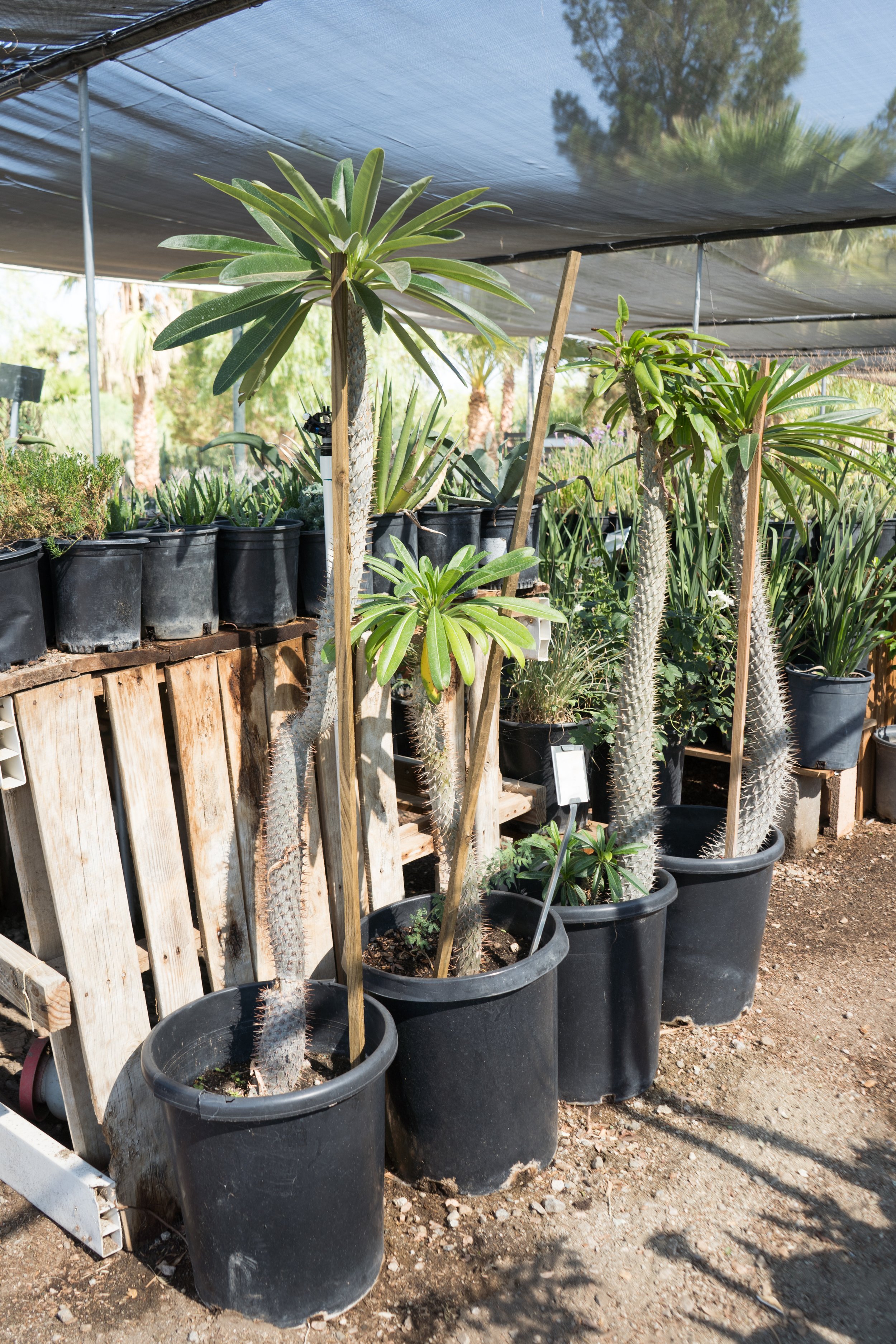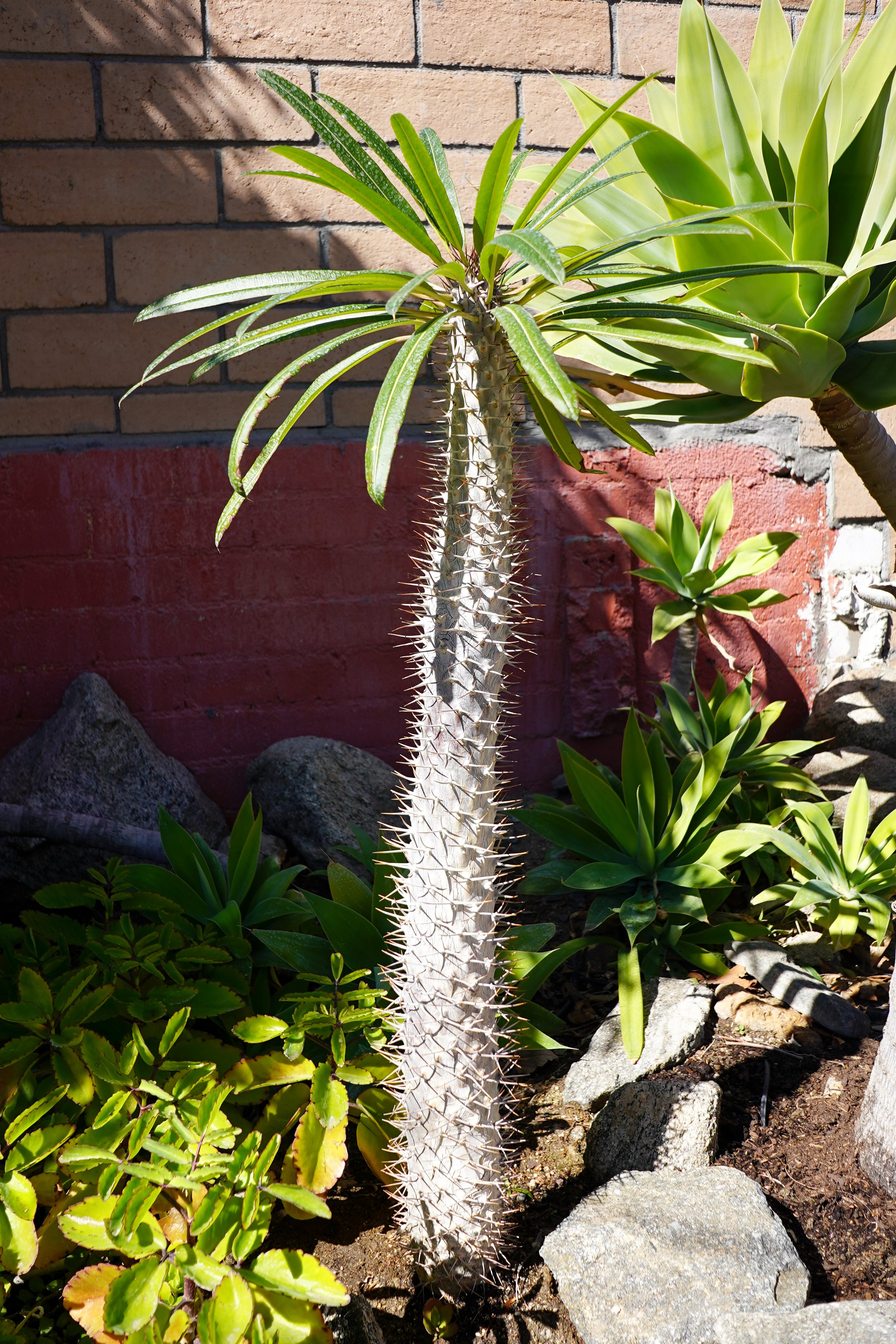Madagascar Palm
Imagine a plant that looks like a palm tree from a distance, but like a cactus up close.
That's Madagascar palm.
Evolved to withstand heat, drought, and irregular water, this tropical succulent is one tough plant. And a great conversation starter for sure.
Botanical name: Pachypodium lamerei
Other names: Pachy Palm, Madagascan Palm
Madagascar Palm for sale at our nursery in 15-gallon containers
TABLE OF CONTENTS
Madagascar Palm Appearance
Madagascar palm is an interesting combination of tropical-looking leaves with a cactus-like stem.
Although not a palm, its nickname derives from its deep green, thin and long leaves that appear on the top of the trunk, similar to a palm.
The long trunk is typically thin when young, and becomes more bulbous when mature. Madagascar palms in their original habitat can reach 20+ feet in height but usually grow to 10-15 feet tall in California.
The trunk, which stores water for conservation, is mostly light gray. Parts of it will turn green so that it can photosynthesize during the growing season. Another way the plant has adapted to drought is through its long, two-inch thorns that cover the entire stem.
Most young Madagascar palms have a single stem, but some branch out as they get older.
Showy, large white flowers when in bloom.
Madagascar Palm Landscaping Tips
Madagascar palms are great for adding vertical interest, a sense of whimsy, or a tropical feel while being drought-tolerant.
They look great in clusters of staggered height, whether planted in the ground or in containers. Be mindful of very long thorns and toxic sap when handling.
Madagascar palm naturally sheds its leaves when it's dormant during the dry season. They will reappear in the spring. To keep the leaves year-round, maintain consistent irrigation and avoid frost.
To create branches or to keep to the desired height, you can cut the top part of the plant.
Easy houseplant with sufficient light. It will grow slowly and to a shorter height when grown indoors.
Madagascar Palm Origin
Madagascar, in areas that experience drought and heat.
Close up look at Madagascar palm
Madagascar Palm Care
Madagascar palm is highly tolerant of drought and heat but not frost.
Soil: Loose, well-draining soil that is moderately fertile. Cactus or succulent soil mixes work well.
Temperature: Can withstand temperatures down to 40 degrees for a short period of time. Does very well in the heat.
Water: Occasional, deep watering. Allow the soil to completely dry out between waterings. Either use a moisture meter or stick your finger through the soil to gauge the moisture level. It’s better to err on the side of underwatering than overwatering.
Sun: Full sun to partial shade
Madagascar Palm Problems
Pests: Madagascar Ocotillo has minimal pests.
Fungal diseases from root rot, dry rot, and harsh weather conditions.
Signs of overwatering: Drooping, squishy texture (especially an the bottom of the plant), leaf shedding
Signs of too little water: Shriveling, drying skin, leaf shedding
Signs of too much sun: Burning, scarring
Signs of too little sun: Etiolation, discoloring
Madagascar Palm Propagation
The easiest way to propagate the Madagascar palm is to cut off the offsets that grow from the main plant.
You can also take and plant the seeds once fruits have developed.
FAQ
How much does Madagascar palm cost?
At our nursery, Madagascar palms cost $55 for a 5-gallon container, $150 for a 15-gallon container, and $350 for a 24” box.
Prices are subject to change. Please contact us for the most up-to-date information on pricing. We may have larger sizes available. We provide installation services locally at a separate cost.
Why are the leaves falling off my Madagascar palm?
The most likely reasons for a Madagascar palm losing leaves are not enough water, cold temperatures, and transplant shock. In its original habitat, Madagascar palms shed leaves during the colder and drier season and regain them with higher humidity and warmth.
Is Madagascar palm toxic?
Yes. Madagascar palm has clear sap that is toxic. Handle the plant with care and use extra protection.
Summary
| SIZE (H X W) | 15 feet |
|---|---|
| FLOWER COLOR | White |
| FLOWER SEASON | Spring to Summer |
| EXPOSURE | Full Sun to Partial Sun |
| WATER | Low |
| GROWTH RATE | Moderate |
| HARDINESS | 40º F, USDA Zone 9 |
| PRUNING | None |

